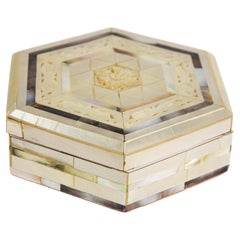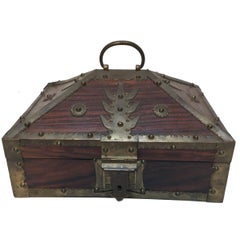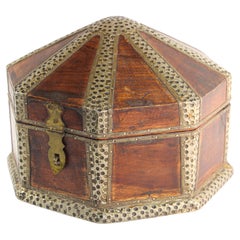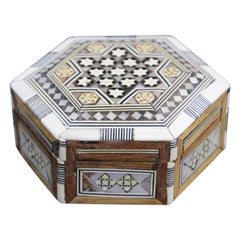Want more images or videos?
Request additional images or videos from the seller
1 of 8
Decorative Round Opium Container Box Inlaid with White Bone and Brass
Price:$156
About the Item
- Dimensions:Height: 3 in (7.62 cm)Diameter: 6.5 in (16.51 cm)
- Style:Moorish (In the Style Of)
- Materials and Techniques:
- Place of Origin:
- Period:
- Date of Manufacture:20th Century
- Condition:Wear consistent with age and use.
- Seller Location:Moreno Valley, CA
- Reference Number:Seller: 320521stDibs: LU906817884611
About the Seller
5.0
Platinum Seller
Premium sellers with a 4.7+ rating and 24-hour response times
1stDibs seller since 2011
3,215 sales on 1stDibs
Typical response time: 1 hour
Authenticity Guarantee
In the unlikely event there’s an issue with an item’s authenticity, contact us within 1 year for a full refund. DetailsMoney-Back Guarantee
If your item is not as described, is damaged in transit, or does not arrive, contact us within 7 days for a full refund. Details24-Hour Cancellation
You have a 24-hour grace period in which to reconsider your purchase, with no questions asked.Vetted Professional Sellers
Our world-class sellers must adhere to strict standards for service and quality, maintaining the integrity of our listings.Price-Match Guarantee
If you find that a seller listed the same item for a lower price elsewhere, we’ll match it.Trusted Global Delivery
Our best-in-class carrier network provides specialized shipping options worldwide, including custom delivery.You May Also Like
Petite Chinese Opium Box, c. 1850
Located in Chicago, IL
A petite 19th century canister once used to store a smoker's personal supply of opium paste. A keepsake from a bygone era, the small box is formed of brass and provided an airtight s...
Category
Antique 19th Century Chinese Qing More Asian Art, Objects and Furniture
Materials
Brass
Chinese Bronze Opium Box, c. 1900
Located in Chicago, IL
A petite bronze canister once used to store a smoker's personal supply of opium paste. A keepsake from a bygone era, the small box dates to the early 20th century and provided an air...
Category
Early 20th Century Chinese Qing More Asian Art, Objects and Furniture
Materials
Bronze
Chinese Bronze Opium Box, c. 1900
Located in Chicago, IL
A petite bronze canister once used to store a smoker's personal supply of opium paste. A keepsake from a bygone era, the small box dates to the early 20th century and provided an air...
Category
Early 20th Century Chinese Qing More Asian Art, Objects and Furniture
Materials
Bronze
Erotic Chinese Baitong Opium Box, c. 1850
Located in Chicago, IL
A petite white brass (baitong) canister once used to store a smoker's personal supply of opium paste. Dated to the 19th-century, the box is an example of Qing-dynasty erotica, incorp...
Category
Antique Mid-19th Century Chinese Qing More Asian Art, Objects and Furniture
Materials
Brass
Chinese Copper Coin Opium Box, c. 1900
Located in Chicago, IL
A petite 19th century canister once used to store a smoker's personal supply of opium paste. A keepsake from a bygone era, the small box is formed of antique coins and copper and pro...
Category
Antique Late 19th Century Chinese Qing More Asian Art, Objects and Furni...
Materials
Copper
18th century Dutch-Colonial ‘Vizagapatam’ pen-engraved bone inlaid ebony box
Located in Amsterdam, NL
A large Indian Colonial ‘Vizagapatam’ pen-engraved bone inlaid ebony box
Masulipatnam or Vizagapatam, 2nd half 18th century
H. 10.8 x W. 47 x D. 34 cm
...
Category
Antique Late 18th Century Indian Dutch Colonial More Asian Art, Objects ...
Materials
Bone, Ebony
$41,923
Free Shipping
H 4.26 in W 18.51 in D 13.39 in
Provincial Chinese Wooden Box with Bone Chopstick Handles
Located in Chicago, IL
A narrow wooden box with a sliding lid and a pair of carved bone chopstick handles with contrasting dark inlay at the ends. The bone handles were likely originally affixed to chopsti...
Category
Antique Mid-19th Century Chinese Qing More Asian Art, Objects and Furniture
Materials
Wood, Bone
Chinese Altar Opium Stand with Dali Marble, c. 1850
Located in Chicago, IL
Dated to the mid-19th century, this petite hardwood box captures in miniature the elaborate form of a traditional Chinese altar table. Crafted of a dense hardwood, the narrow box is ...
Category
Antique Mid-19th Century Chinese Qing More Asian Art, Objects and Furniture
Materials
Marble
Late Qing Dynasty Document Box with Brass Lock and Carrying Handles
Located in Yonkers, NY
An antique Chinese Late Qing Dynasty period wooden document box from the early 20th century with reddish brown lacquer, brass hardware and carrying handles. Created in China during the late Qing Dynasty period in the early years of the 20th century, this wooden document box features a domed lid opening thanks to a traditional brass lock...
Category
Early 20th Century Chinese Qing Decorative Boxes
Materials
Brass
19th Century Indian Wooden Box with Brass Details and Distressed Patina
Located in Yonkers, NY
An antique Indian wooden box from the 19th century, with brass details and weathered appearance. Topped with a rectangular lid fitted with a c-scroll handle and half opening to revea...
Category
Antique 19th Century Indian Decorative Boxes
Materials
Brass
More From This Seller
View AllHandcrafted White Mother of Pearl Inlaid Moorish Octagonal Box
Located in Moreno Valley, CA
Exquisite handcrafted white mother of pearl inlaid and hand carved lidded box.
Small octagonal Anglo Indian decorative box intricately decorated with Moorish motif designs which hav...
Category
Mid-20th Century Indian Moorish Decorative Boxes
Materials
Shell, Fruitwood, Abalone, Mother-of-Pearl
Ethnic Indian Decorative Jewelry Box with Brass, Kerala Nettur Petti
By Rajhastani
Located in Moreno Valley, CA
Large Teak Jewelry Dowry Box with Brass, Late 19th Century, India.
This Teak Indian Dowry Box is adorned with Decorative Brass, showcasing exquisite c...
Category
Antique 1890s Indian Agra Decorative Boxes
Materials
Brass
Large Asian Decorative Wooden Jewelry Box with Hammered Brass Metal Overlay
By Rajhastani
Located in Moreno Valley, CA
Large Asian decorative wooden jewelry box with brass overlay.
Large ethnic Indian hand painted decorative jewelry wood box with brass metal hammere...
Category
Mid-20th Century Indian Agra Decorative Boxes
Materials
Brass
Moorish Handcrafted Octagonal Box with White Mosaic Marquetry
Located in Moreno Valley, CA
Exquisite handcrafted Middle Eastern Lebanese mosaic marquetry wood box.
Small octagonal walnut Syrian style box intricately decorated with Moorish...
Category
Mid-20th Century Lebanese Moorish Decorative Boxes
Materials
Fruitwood, Shell
Anglo-Indian Vizagapatam Bombay Mughal Style Footed Box With Bone Overlay
Located in Moreno Valley, CA
Nice and unusual Indian Mughal style large decorative box, filigree and carved horn.
Anglo-Indian footed domed box with exceptional engraved details throughout with filigree and carved veneered bone plaques with arabesque carving.
Vizagapatam, late 19th century.
History of the Anglo-Indian Boxes
Beginning in the early part of the 18th century, Indian artisans made what came to be known as Anglo-Indian boxes for the English residents living in India, who eventually brought or sent them back to England. At the beginning of the 19th century, India began exporting these boxes commercially, although not in any significant numbers until the 1850s. People valued them so highly that manufacturers of tins copied the designs on them in the late 19th and early 20th century.
Anglo-Indian boxes fall into four groups: Rosewood or ebony boxes inlaid;
sandalwood boxes veneered; sandalwood boxes covered with Sadeli mosaic; and carved boxes often combined with Sadeli mosaic/
The first two categories came from Vizagapatam in East India while the last two came from Bombay in West India.
English traders discovered the rich woods and intricate workmanship of Indian artisans, so colonial government officials began to recognize the work of the Indian artists and craftsmen as a source for satisfying the need for furniture and boxes, which would both serve to enhance English households in India. This gave rise to the cabinetmaking workshops in Vizagapatam between Calcutta and Madras.
Craftsmen made the first boxes to be decorated with Sadeli mosaic of rosewood or ebony, incised to give further definition to the decoration, directly inlaid into the wood. The shape of the early boxes was either sloping at the front with a flatter section at the back, reminiscent of English writing slopes, or rectangular. Artisans inlaid the borders with stylized floral scrolls and the centers with a single floral motif following a circular or oval symmetrical or asymmetrical pattern. The edging was ornamental and protective, both helped protect the end grain against the weather.
Made in Vizagapatam, situated on the south east coast of India, near Madras
These exotic boxes...
Category
Antique Late 19th Century Indian Anglo Raj Decorative Boxes
Materials
Wood
Moorish Micro Mosaic Inlaid Jewelry Box
By Rajhastani
Located in Moreno Valley, CA
Moorish style micro mosaic marquetry inlaid jewelry box with lid.
Intricate inlaid Anglo Indian box with floral and geometric Islamic
Moorish mosaic Sadeli design in a square shape form with mosaic inlay and marquetry, very fine artwork, lined in red velvet.
Museum collector piece like the one in Doris Duke Islamic Art Museum.
The repeating geometric patterns of Sadeli Mosaic are what give it beauty and richness. This decorative technique is a type of micro mosaic featuring repeating geometric patterns. A highly skilled craft, it has had a long history in India and the Middle East with early examples dating back to the 16th century. In the 1800s, it became popular as a decoration on a variety of boxes, card cases, and chess boards imported from India. Since Bombay became a center of making them, they became known as Bombay boxes...
Category
Mid-20th Century Indian Agra Jewelry Boxes
Materials
Wood



